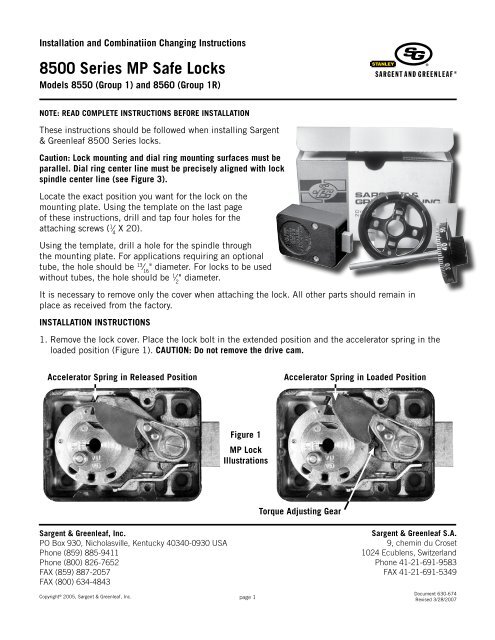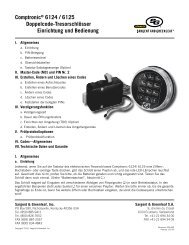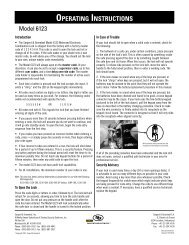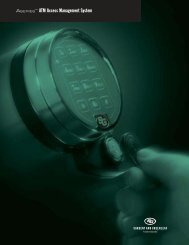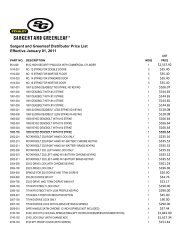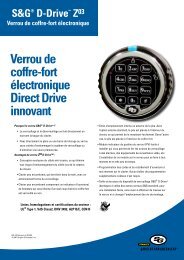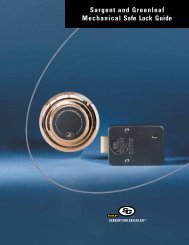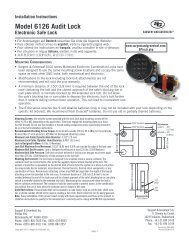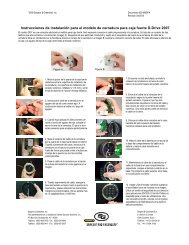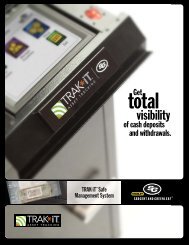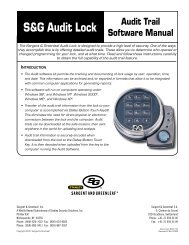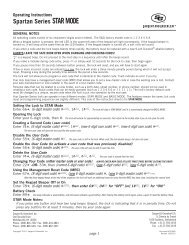8500 Series MP Safe Locks - Sargent and Greenleaf
8500 Series MP Safe Locks - Sargent and Greenleaf
8500 Series MP Safe Locks - Sargent and Greenleaf
Create successful ePaper yourself
Turn your PDF publications into a flip-book with our unique Google optimized e-Paper software.
Installation <strong>and</strong> Combinatiion Changing Instructions<br />
<strong>8500</strong> <strong>Series</strong> <strong>MP</strong> <strong>Safe</strong> <strong>Locks</strong><br />
Models 8550 (Group 1) <strong>and</strong> 8560 (Group 1R)<br />
NOTE: READ CO<strong>MP</strong>LETE INSTRUCTIONS BEFORE INSTALLATION<br />
These instructions should be followed when installing <strong>Sargent</strong><br />
& <strong>Greenleaf</strong> <strong>8500</strong> <strong>Series</strong> locks.<br />
Caution: Lock mounting <strong>and</strong> dial ring mounting surfaces must be<br />
parallel. Dial ring center line must be precisely aligned with lock<br />
spindle center line (see Figure 3).<br />
Locate the exact position you want for the lock on the<br />
mounting plate. Using the template on the last page<br />
of these instructions, drill <strong>and</strong> tap four holes for the<br />
attaching screws ( 1 ⁄ 4 X 20).<br />
Using the template, drill a hole for the spindle through<br />
the mounting plate. For applications requiring an optional<br />
tube, the hole should be 13 ⁄ 16 " diameter. For locks to be used<br />
without tubes, the hole should be 1 ⁄ 2 " diameter.<br />
It is necessary to remove only the cover when attaching the lock. All other parts should remain in<br />
place as received from the factory.<br />
INSTALLATION INSTRUCTIONS<br />
1. Remove the lock cover. Place the lock bolt in the extended position <strong>and</strong> the accelerator spring in the<br />
loaded position (Figure 1). CAUTION: Do not remove the drive cam.<br />
Accelerator Spring in Released Position Accelerator Spring in Loaded Position<br />
<strong>Sargent</strong> & <strong>Greenleaf</strong>, Inc.<br />
PO Box 930, Nicholasville, Kentucky 40340-0930 USA<br />
Phone (859) 885-9411<br />
Phone (800) 826-7652<br />
FAX (859) 887-2057<br />
FAX (800) 634-4843<br />
Copyright © 2005, <strong>Sargent</strong> & <strong>Greenleaf</strong>, Inc.<br />
Figure 1<br />
<strong>MP</strong> Lock<br />
Illustrations<br />
page 1<br />
Torque Adjusting Gear<br />
<strong>Sargent</strong> & <strong>Greenleaf</strong> S.A.<br />
9, chemin du Croset<br />
1024 Ecublens, Switzerl<strong>and</strong><br />
Phone 41-21-691-9583<br />
FAX 41-21-691-5349<br />
Document 630-674<br />
Revised 3/28/2007
2. Mount the lock in place with four 1 ⁄ 4 X 20 attaching screws (provided).<br />
3. Attach the dial ring by loosely installing the attaching screws to hold the dial ring in place for alignment.<br />
The dial ring opening index should be at the 12 o’clock center position.<br />
4. To install the dial, hold the drive cam in place with one h<strong>and</strong> <strong>and</strong> thread the dial/spindle assembly into<br />
the cam until the dial comes to a stop against the surface of the dial ring.<br />
Caution: When threading the dial into the cam, do not allow the cam to slide outward against the accelerator<br />
spring. The accelerator spring can be easily damaged in this manner.<br />
5. The alignment of the dial <strong>and</strong> ring is critical to the proper operation of the lock. Perfect alignment must<br />
be obtained. The dial should be flush <strong>and</strong> centered with the surface of the dial ring for true centering<br />
(Figure 2).<br />
Figure 2<br />
Changing Index Opening Index<br />
Misaligned Aligned<br />
6. Measure the excess spindle that projects beyond the drive cam (Figure 3)<br />
page 2<br />
Dial Edges<br />
Flush with Ring<br />
7. Remove the dial, cut off the excess spindle, <strong>and</strong> remove any burrs from the end. You may also find that<br />
the spindle threads more easily into the drive cam after cutting if the spindle end is beveled slightly.<br />
Excess Spindle<br />
Figure 3
8. Tighten the dial ring screws.<br />
9. Place a flat washer, the compression spring, <strong>and</strong> another flat washer over the spindle <strong>and</strong> into the recess<br />
at the dial hub (Figure 4).<br />
Figure 4<br />
10. Insert the dial into the lock, but remember that you should not allow the cam to slide outward against<br />
the accelerator spring, possibly damaging it. Hold the drive cam in place, positioned for its gate to<br />
receive the nose of the drop lever, <strong>and</strong> thread the dial into the cam until the dial stops.<br />
11. Turn the dial counterclockwise until zero is aligned with the opening index of the dial ring, then turn<br />
the dial one turn farther counterclockwise. When this is done, the proper spindle spline keyway <strong>and</strong><br />
drive cam spline keyway should be closely aligned (vertical-up—VU, right-h<strong>and</strong>—RH, etc.).<br />
Spline Key<br />
Gate<br />
Figure 5<br />
LH Mount RH Mount<br />
12. Insert the spline key with the tip toward the edge of the cam. Tap in lightly. Be very careful to avoid<br />
striking the stainless steel roller that is attached to the top surface of the drive cam. With the spline<br />
key inserted fully, the dial must turn freely with no rubbing or interference.<br />
Note: Before installing the lock‘s cover, check for proper in <strong>and</strong> out travel of the dial to make sure the<br />
accelerator spring operates correctly.<br />
13. Turn the dial at least one complete revolution in either direction <strong>and</strong> then stop at zero. The accelerator<br />
spring should now be in the loaded position.<br />
14. Hold the cover in place on the lock <strong>and</strong> push the dial in at zero. Release the dial. Remove the<br />
cover <strong>and</strong> check the position of the accelerator spring. It should be in the released position. If the<br />
accelerator spring is not in the released position, the dial has not been backed out of the cam far<br />
enough, <strong>and</strong> the condition must be corrected. Remove the spline key, hold the cam, <strong>and</strong> rotate the dial<br />
one additional full turn counterclockwise. Install a new spline key <strong>and</strong> repeat steps 13 <strong>and</strong> 14.<br />
page 3<br />
VU Mount<br />
VD Mount
15. Turn the dial at least one complete revolution in either direction, then stop at 50. The accelerator<br />
spring should now be in the loaded position.<br />
16. Hold the lock cover in place <strong>and</strong> push the dial in at 50. The accelerator spring should not release. If<br />
the accelerator spring does release, the spindle must be turned clockwise into the cam one revolution<br />
<strong>and</strong> the lock checked again, beginning at step 13.<br />
17. Dial the factory combination (4 times left to 50, right to 0, push in, let the dial out, turn right until<br />
the dial comes to a stop at about 85) <strong>and</strong> observe the drop lever falling into the drive cam. Repeat this<br />
step at least three times, checking to make sure the drop lever falls into the drive cam gate each time.<br />
18. When the accelerator spring is operating properly, the cover may be attached to the lock <strong>and</strong> the new<br />
combination set.<br />
FOR LOCKS INSTALLED WITH OPTIONAL TUBE KIT (PART NO. U24)<br />
1. Install the optional tube kit to the lock body, then fasten the lock to the mounting plate.<br />
2. Measure <strong>and</strong> mark the tube where it exits from the spindle hole at the front of the safe door. Remove the<br />
lock <strong>and</strong> move your mark .120" (3 mm) farther toward the end of the tube. This slight extra length will<br />
protrude through the front of the safe door <strong>and</strong> seat into the underside of the dial ring bearing when the<br />
lock is re-installed. Cut off the excess tube at your new mark.<br />
3. Remove any burrs from the end of the tube, replace the lock <strong>and</strong> ring on the door, <strong>and</strong> proceed with<br />
Step 4 of the installation instructions (page 2).<br />
DIALING THE COMBINATION TO OPEN THE LOCK<br />
Before operating the lock or changing the combination, read these instructions thoroughly.<br />
On the dial ring are two index marks. The one at the top is for normal dialing <strong>and</strong> opening. The index to the<br />
left is provided for use only when changing the combination.<br />
Turn the dial slowly <strong>and</strong> steadily. If, after turning the correct number of revolutions, any number is turned<br />
beyond the index mark, the entire series of combination numbers must be re-dialed. You cannot back up<br />
to a number if you pass it when you meant to stop on it. Each time a selected number is aligned with the<br />
opening index, it counts as one revolution, even if you only have to turn the dial a few numbers to achieve<br />
the initial alignment.<br />
CAUTION: The dial should not be pushed in until the combination has been dialed <strong>and</strong> the dial returned to zero<br />
at the opening index.<br />
TO UNLOCK ON A FACTORY COMBINATION<br />
1. Turn the dial counterclockwise (left) , stopping when 50 is aligned with the opening index the fourth<br />
time.<br />
2. Turn the dial clockwise (right), stopping when 0 is aligned with the opening index the first time.<br />
3. With 0 aligned at the opening index, push the dial in firmly, then release it to activate the lever<br />
assembly.<br />
4. Turn the dial clockwise until the bolt retracts. The dial should come to a positive stop at about 85. If the<br />
combination has been correctly dialed, the safe or cabinet may be opened.<br />
page 4
TO LOCK<br />
Turn the dial counterclockwise (left) at least five complete revolutions for maximum security.<br />
COMBINATION CHANGING FROM 50 - 0<br />
Make up a new combination, selecting three numbers of your own choosing. Do not set the third number<br />
of the combination between 90 <strong>and</strong> 99 or 0 <strong>and</strong> 10. This area is known as the forbidden zone. Adjacent<br />
combination numbers should be at least 5 numbers apart. Numbers that end with 0 or 5 should not be<br />
used for all combination numbers. Do not use strictly ascending (ex. 22-45-83) or descending (ex. 83-45-<br />
22) combination sequences. Also, do not use numbers someone could easily guess.<br />
Caution: Only use change key U8 or U9 on the <strong>8500</strong> series lock. Other keys will not function properly <strong>and</strong> may<br />
damage the lock.<br />
1. Turn the dial counterclockwise, stopping when 50 is aligned with the changing index the fourth time.<br />
2. Leave the dial on 50 at the changing index <strong>and</strong> insert the change key into the hole in the back of the<br />
lock. Insert the key until the wing is entirely inside the lock <strong>and</strong> the key comes to a positive stop.<br />
WARNING: Never insert the change key into the lock when the cover is removed. Always be certain the change<br />
key is entirely within the lock before turning the key.<br />
3. Turn the key one quarter turn counterclockwise. With the change key in this position, turn the dial<br />
counterclockwise, stopping when the first number of the newly selected combination aligns with he<br />
changing index the FOURTH time.<br />
4. Turn the dial clockwise, stopping when the second number of the combination is aligned with the<br />
changing index the THIRD time.<br />
5. Turn the dial counterclockwise, stopping when the third number is aligned with the changing index the<br />
SECOND time. Holding the dial in this position, turn the change key one quarter turn clockwise to re-lock<br />
the wheels with the new combination installed. Remove the change key from the lock.<br />
The new combination you have selected is now set. After changing the opening combination, the lock<br />
should be opened <strong>and</strong> locked several times with the safe door open. Once the new combination has been<br />
successfully tested, the safe door can be closed <strong>and</strong> locked.<br />
TO UNLOCK ON A SA<strong>MP</strong>LE COMBINATION OF 50 - 25 - 50<br />
1. Turn the dial counterclockwise, stopping when 50 is aligned with the opening index the fourth time.<br />
2. Turn the dial clockwise, stopping when 25 is aligned with the opening index the third time.<br />
3. Turn the dial counterclockwise, stopping when 50 is aligned with the opening index the second time.<br />
4. Turn the dial clockwise, stopping when 0 is aligned with the opening index the first time.<br />
5. When 0 is aligned with the opening index, push the dial in firmly, then release it to activate the lever<br />
assembly.<br />
6. Turn the dial farther clockwise until it comes to a positive stop near 85, indicating that the lock bolt has<br />
retracted. If the combination has been correctly dialed, the safe or cabinet may be opened.<br />
This procedure can be used with any three number combination, substituting selected numbers for the<br />
numbers 50 - 25 - 50.<br />
CAUTION: The dial should not be pushed in at 0 until all three numbers have been dialed <strong>and</strong> 0 is aligned with<br />
the opening index.<br />
page 5
COMBINATION CHANGING FROM A SA<strong>MP</strong>LE COMBINATION OF 50 - 25 - 50<br />
1. Turn the dial counterclockwise, stopping when 50 is aligned with the changing index the fourth time.<br />
2. Turn the dial clockwise, stopping when 25 is aligned with the changing index the third time.<br />
3. Turn the dial counterclockwise, stopping when 50 is aligned with the changing index the second time.<br />
4. Leave the dial with the last number at the changing index <strong>and</strong> insert the change key in the hole in the<br />
back of the lock. Insert the key until the wing is entirely inside the lock <strong>and</strong> comes to a positive stop.<br />
5. Turn the key one quarter turn counterclockwise. With the change key in this position, turn the dial<br />
counterclockwise, stopping when the first number of the newly selected combination aligns with he<br />
changing index the FOURTH time.<br />
6. Turn the dial clockwise, stopping when the second number of the new combination is aligned with the<br />
changing index the THIRD time.<br />
7. Turn the dial counterclockwise, stopping when the third number of the new combination is aligned with<br />
the changing index the SECOND time. Holding the dial in this position, turn the change key one quarter<br />
turn clockwise to relock the wheels with the new combination installed. Remove the change key from<br />
the lock.<br />
The new combination you have selected is now set. After changing the opening combination, the lock<br />
should be opened <strong>and</strong> locked several times with the safe door open. Once the new combination has been<br />
successfully tested, the safe door can be closed <strong>and</strong> locked.<br />
Important: do not select codes such as birthdays or other predictable sequences which could provide a<br />
correlation between the user <strong>and</strong> the safe combination.<br />
TORQUE ADJUSTMENT<br />
The torque adjustment feature allows the wheel pack tension to be adjusted for maximum security. To<br />
adjust torque, remove the lock cover <strong>and</strong> insert a 3 ⁄ 32 " hex wrench into the adjusting gear (see Figure 1).<br />
Turn clockwise to increase torque or counterclockwise to decrease torque. This adjustment should only be<br />
performed by a skilled technician using a specialized torque measuring tool.<br />
Note: Manipulation proof locks should not be adjusted to less than 18 inch-ounces of dialing torque.<br />
CAUTION: Whenever the lock‘s torque setting is changed, the combination must be reset (18-20 in-oz).<br />
SERVICING (should only be performed by a qualified locksmith or safe technician)<br />
Periodic servicing will extend the life of your lock <strong>and</strong> is essential for maintaining security. To perform<br />
proper service, follow these instructions.<br />
1. Remove the lock cover.<br />
2. Remove the lever screw <strong>and</strong> lever assembly. Be sure to remove the lever control tension spring (small<br />
“Z” spring) so you won’t misplace it.<br />
3. Using a pair of side cutters, grip the head of the spline key as close as possible to the surface of the<br />
drive cam. Lift straight up, being careful not to bend the key. The edge of the case may be used for<br />
leverage as long as minimal force is used.<br />
page 6
4. Unscrew the dial <strong>and</strong> spindle assembly from the lock. Remove the drive cam.<br />
5. Remove the Spirolox ® retainer from the top of the wheel post.<br />
6. Remove the wheels <strong>and</strong> associated parts. Place them in sequence so they can be re-installed in the<br />
proper order.<br />
7. Remove the lock bolt. Do not misplace the detent ball or detent spring.<br />
8. Remove the dial <strong>and</strong> spindle assembly from the dial ring.<br />
CAUTION: Remove the washers <strong>and</strong> spring from the dial carefully so they can be re-installed later.<br />
The lock is now completely disassembled <strong>and</strong> ready for servicing.<br />
SERVICE AND REASSEMBLY<br />
1. Tighten the attaching screws for the dial ring <strong>and</strong> lock body.<br />
2. Wipe each wheel, the wheel post, <strong>and</strong> other bearing surfaces clean. Wipe the complete interior of the<br />
lock case clean.<br />
Note: S&G recommends Novagard G322L ® Versilube, Dow Corning Gn Metal Paste ® , or Shell Aeroshell 22 ® for<br />
lock lubrication. Use of other lubricants will void the product warranty.<br />
3. Lightly (means a thin film) grease the bolt where it normally rubs against the lock case. Install the<br />
detent spring <strong>and</strong> detent ball before sliding the bolt back into the lock case. It will be necessary to<br />
depress the re-lock trigger to slide the bolt back into the case.<br />
4. Be sure to carefully examine each wheel part as well as the cam <strong>and</strong> lever assembly to make sure<br />
nothing is worn or damaged.<br />
5. Lightly grease the bearing surface of the wheel post <strong>and</strong> drive cam bearing. Replace the wheels <strong>and</strong><br />
parts exactly as they were before disassembly. Reset the wheel pack torque to a value between 18 <strong>and</strong><br />
22 inch-ounces. Screw the dial/spindle assembly <strong>and</strong> cam together until snug. Hold the cam <strong>and</strong> turn<br />
the dial back one complete turn, then align the spline keyways. Insert the spline key. For proper key<br />
installation, see Figure 6 on page 3.<br />
I<strong>MP</strong>ORTANT: It is recommended that a new spline key be used each time the lock is serviced.<br />
6. Lightly grease the bearing surface of the lever bushing <strong>and</strong> install the lever. Tighten the lever screw<br />
snugly <strong>and</strong> carefully. Position the lever control tension spring. Be careful not to bend the accelerator<br />
spring. Lever screw torque should be between 22 <strong>and</strong> 26 inch-pounds).<br />
7. Install the lock cover. Make sure the cover screws are tight.<br />
8. Reset the combination.<br />
9. Check the combination at least three times before locking the safe.<br />
page 7
ERRORS<br />
The most frequent error in the changing procedure is dialing the number to the wrong index. Occasionally<br />
all the numbers may be dialed to the opening index rather than the changing index. More often, dialing<br />
part of the combination to the changing index <strong>and</strong> part to the opening index occurs. As long as the door is<br />
open, the error is easily corrected.<br />
PROCEDURE<br />
1. Remove the cover from the lock.<br />
2. Insert a straightened paper clip or similar instrument (NOT the change key) in the square keyways of the<br />
wheels.<br />
3. Rotate each wheel until all the keyways are in perfect alignment directly over the small hole in the<br />
bottom of the case where the tip of the change key seats during normal changing operations. There are<br />
two holes in the bottom of the case. Use the one that normally lines up with the change key hole in the<br />
lock cover (when the cover is in place on the lock body).<br />
4. Replace the cover <strong>and</strong> insert the change key. Replace the cover screws. NEVER INSERT A CHANGE KEY<br />
INTO THE LOCK WHEN THE COVER IS REMOVED! Always be certain that the wing of the change key is<br />
entirely within the lock before turning the key.<br />
5. Turn the change key one quarter turn counterclockwise <strong>and</strong> dial the new combination to the changing<br />
index. Once all the combination numbers have been entered into the lock, turn the key back <strong>and</strong> remove<br />
it from the lock.<br />
6. With the combination now set, try the combination at the opening index at least three times before<br />
closing the door. You should also be able to dial the combination ½ number high <strong>and</strong> ½ number low on<br />
all combination numbers.<br />
VERTICAL-UP<br />
11<br />
⁄16 "<br />
(17,5 mm)<br />
LOCK TE<strong>MP</strong>LATE<br />
LEFT-HAND<br />
13<br />
⁄16 "<br />
(20,6 mm)<br />
RIGHT-HAND<br />
page 8<br />
1 15 " (49,2 mm)<br />
⁄16<br />
VERTICAL-DOWN


